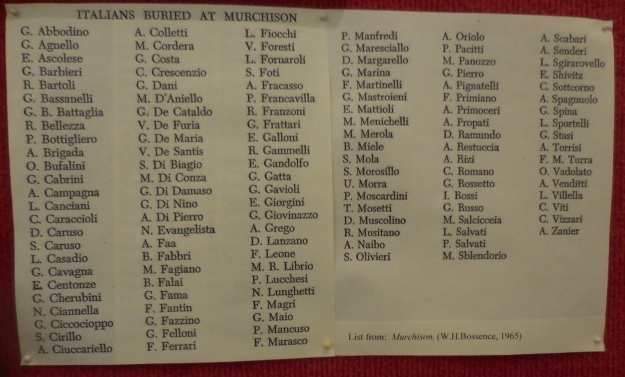There are two Italian prisoners of war whose names might not be on any memorial but should be acknowledged.
Fedanzi Primo DELORENZO died on 22nd May 1941, from pneumonia on the voyage from Egypt to Australia May 1941. He was buried at sea, off the Western Australian coast, with full military honours.
Concettino SANTUCCI was on the repatriation ship “Empire Clyde” when he died: 27th December 1946. He was from Magliano De’ Marsi L’Aquila.
**************************************************************************
The complexity of the war time policy of interment in Australia is mirrored by the backgrounds of the Italian men, woman and child who have been laid to rest in The Ossario.
The list below informs visitors to The Ossario of the Italians buried in the complex. Lists are important but their purpose is limited. Feeling that every Italian laid to rest deserves more than their name on a list, I have delved into each person’s story. What I found while researching these names is that there is a history lesson in the details. I have learnt more about the complexity of war.
Tunnel vision, saw me focus on the five Italian prisoners of war who died in Queensland. The Ossario however is the final resting place for 130 Italians: 128 men, one woman and one baby. Furthermore, one Italian prisoner of war drowned and his body was never recovered; therefore there is no public acknowledgement of this man’s death.

Italians Buried at Murchison
(photo courtesy of Alex Miles)
From the names on the list, I have learnt about Italians, residents of the British Isles, who were interned and sent to Australia on the infamous Dunera. I have read about the Remo and Romolo, Italian passenger ships in Australian waters when Italy declared war and scuttling of the Romolo in the Coral Sea. Italian internees were also sent to Australia from Palestine and New Guinea.
Details of Italian Internees who died in Australia 1941-1946 provides a little of the history for each internee resting at The Ossario.
Details of Italian Prisoners of War who died in Australia 1942-1946 provides a little of the background for each prisoner of war resting at The Ossario.
Three Italians whose freedom was taken from them and died in Australia deserve a specific mention:
MR Librio is Mario Roberto infant son of Andrea and Giuseppina Librio. His parents were interned in Palestine and they arrived in Australia onboard Queen Elizabeth 23rd August 1941. His life was short: he was born 4th May 1942 and died 12th May 1942.

Mario Roberto Librio’s Family
Tatura, Australia. 10 March 1945. Group of Italian internees at No. 3 Camp, Tatura Internment Group. Back row, left to right: 20091 Andrea Librio; 20092 Giuseppina Librio; 20094 Concetta Librio; 20093 Giuseppe Librio. Front Row: 20095 Umberto Librio; 20096 Maria Librio. Note: The number is an assigned POW number. (AWM 030247/03 Photographer Ronald Leslie Stewart)
Cafiero Veneri was an Italian soldier captured at Sidi el Barrani on 11th December 1940. He arrived in Australia from India on the Mariposa 26th April 1944. He was the son of Aldreo Veneri and Maria Fabbri from Porto Fuori Ravenna. He was 32 years old when he drowned at Mornington on 23rd December 1945; caught in an undertow at Point Nepean, his body was never recovered.
Attilio Zanier was an Italian soldier captured at Asmara on 28th April 1941. He arrived in Australia from India on the Mariposa 5th February 1944. He was 42 years old when he was gored by a bull on a farm in the W12 PWCC Narembeen district. His death notice was advertised in The West Australian, a tribute from the Hall family:
Zanier (Attilio) – Accidentally killed on Frimley Farm Narembeen, on September 3 1944. Attilio Zanier (prisoner of war). A stranger in a strange land. Husband of Erminia de Comun, fond father of Alcide of Ravascletto Udine Italia. Deeply regretted by the Hall family. (1944 ‘Family Notices’, The West Australian (Perth, WA : 1879 – 1954), 5 September, p. 1. , viewed 25 Feb 2019, http://nla.gov.au/nla.news-article44976920)
There has been an overwhelming generalisation that there were many POWs who committed suicide especially during 1946 when the men were desperate to return home to Italy. The nature and/or cause of death for the 95 Italian prisoners of war is illustrated in the graph below. The numbers speak for themselves.

PS The main focus of my research has been Italian prisoners of war in Queensland. Their history is one small part of the bigger picture. War is complicated and complex as were the groups of men, women and children who were interned in prisoner of war camps in Australia: Italian and German prisoners of war in other Australian states; Australian residents who were German, Italian, Austrian, Hungarian, Polish, Japanese, Spanish … who were interned; German and Italians who were resident in United Kingdom and interned in Australia; Italian families who were living in Palestine and interned in Australia; and Italian and Austrian merchant seaman who were interned in Australia.






